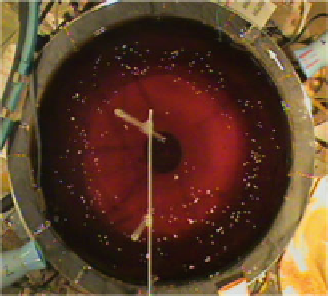Geoscience Reference
In-Depth Information
the heated cable became alkaline and changed its color, from maize yellow to dark
blue. Radial propagation of warm buoyant jet from the heated cable toward the
center of the tank was well marked by the blue color (Fig.
2a
). The paper pellets
were added to the free surface to visualize the azimuth flow and recalculate surface
velocity fields. Data processing was performed using Tank Field Calculator, Excel,
and Surfer.
3 Results
3.1 Development of the Temperature Front in the Presence
of Slope
The laboratory experiments with rotation have shown that the radial velocity of the
warm buoyant jet propagation toward the center of the tank depends on rotation rate
(Coriolis parameter,
f
) and the rate of cable heating (specific power supply,
q
). In
both cases (with and without rotation) the radial velocity of the jet increased with
the rate of cable heating. It was revealed that in rotating fluid a strong along-wall
cyclonic current is initiated (Fig.
2b
).
The radial velocity of buoyant jet was one order less than in nonrotating fluid.
This effect was produced by the Coriolis force that pressed the buoyant jet to the
tank wall. In the presence of slope, along-shore currents were stable and kept
a
b
65
60
55
50
45
40
35
30
25
25
30
35
40
45
50
55
60
65
70
75
Refe
renc
e Ve
ctors
0.04
0.1254155111
Fig. 2 Case with rotation, slopping bottom, view from above: (a) warm buoyant jet colored in
dark blue propagating from the wall to the deep central part of the tank and (b) velocity field,
calculated from paper pellets displacement using Tank Field Calculator program. Time from the
start of the run is 35 min; specific power supply
q
¼
25.7 Wt/m








































































































































































































































